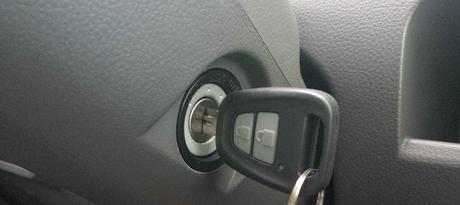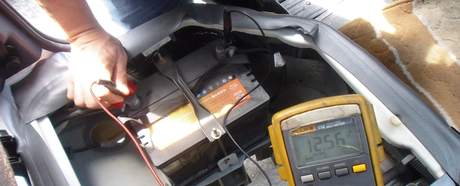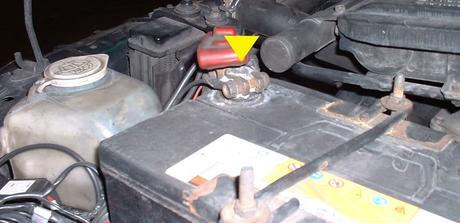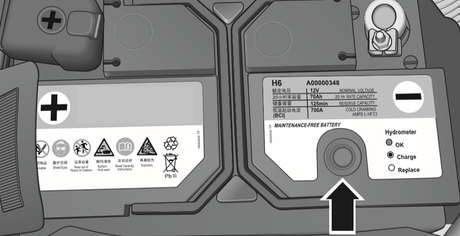 The car turns over but won't start. The car is cranking slowly however, it will not start. If the car is turning over slowly and will not start the possible reason is the battery.
The car turns over but won't start. The car is cranking slowly however, it will not start. If the car is turning over slowly and will not start the possible reason is the battery.The possible reason why the car turns over but won't start
1) The battery terminal is corroded
2) The battery is weak
To determine the reason why car turning over slowly, do the following:1) Turn on the car headlights then start the engine while the headlights were on. Observed the brightness of the headlights if there are changes during starting. If there is any change in the brightness of the headlights then the problem is related to the battery. But if not then it's not a battery-related issue.
Another way to check if the battery has a problem is to check the battery cranking voltage using a voltmeter. Set the voltmeter to DC measurement then connect the voltmeter test lead to the battery pole. Now crank the engine and measure the cranking voltage across the battery terminals. If the cranking voltage is less than 9.5 volts then the battery has a problem. If the voltage across the battery terminals is greater than 9.5 volts then the battery has enough charge to start the engine which means that the problem is not battery related.

2) Open the hood of the car and locate the battery, check the battery terminal. Inspect if there is corrosion on the terminals. Corrosion is looked like a white cruddy substance that is a presence on the cable end and on the top of the terminals. If there is a presence of this substance it will restrict the flow of the current into the starter that is why the car won't start. But if the substance is not present on the terminal then this means that the battery is weak.
What to do if the car turns over but won't start?
(1) Corroded battery terminal
Using a wire brush clean the battery terminal, apply baking soda and water on the terminals while cleaning with a brush to help dissolve the corrosion.

After the terminal is cleaned, apply petroleum jelly on the terminals to help prevents future formation of corrosion on the terminals. Make sure that both battery terminals are coated with petroleum jelly.
How to clean car battery corrosion
The car turns over but won't start because if your car battery is corroded not enough electricity can be passed through the cable to power your car for optimal performance, you can clean away corrosion through simple steps.
What do you need is a brush or an old toothbrush, baking Sod, water. clean cloth, a 10mm wrench, and a wire brush for battery terminal.
Step 1. Mix one tablespoon of baking soda to a two cup of water.
Step 2. Rinse the battery terminal with the mix of baking soda and water.
Step 3. Brush the Terminal thoroughly using an old toothbrush, start from all around the base of the terminal up to the top of the battery pole.
Step 4. Wipe the battery terminal with a towel to dry them off, dry cloth or a rag can be used to dry the terminals. Make sure to wipe all remaining residue around the battery terminal.
Step 5. Now using a wrench usually a 10mm wrench is used, loosen the terminal nut to remove the battery terminal. When removing the battery terminal, remove first the Negative (-) terminal, it is a terminal with a minus sign labeled on the battery and then remove the positive terminal next. Some battery terminal is color-coded so you can easily identify the positive and the negative terminal. The negative terminal is color green and the positive terminal is color red. After loosening the nut, twist the terminal to remove it from the battery pole.
Step 6. Check the battery terminal for a crack, it most common to battery terminal to have a crack on it because of the wear and tear on removing and re-installing frequently, terminals become weak because of corrosion. Check the wire for any damage caused by corrosions. Replace the wire or the terminal if there is damage found on the terminal and the wires. Next is to check the battery for any damage, usually, the casing is the one that is common damage because of vibration.
Step 7. Using a battery brush (wire brush) clean the terminal thoroughly. Also, clean the battery pole using the wire brush until all the corrosion is removed and the battery pole become shine. Clean also the top of the battery by using some of the baking soda and water you've just mix then wipe it and dry it with a clean cloth.
Step 8. After the terminal and the battery pole is cleaned, return the battery terminal to the battery. When installing the battery terminal, install in reverse order as you remove it. INstall the positive terminal first then the negative terminal.
(2) Check if the battery is weak
Open the battery fluid filler cap and check the fluid level. The fluid level should cover the top of the plates, if not then add distilled water just enough to cover the plates and jump-start the car with a good battery. After the car starts, just keep the engine running to charge the battery, let the engine runs for a couple of hours to give time on the battery to have enough charge to run the vehicle going to the battery shop for checking your battery.
Some batteries have an indicator sight glass on top of the battery that indicates your car battery estate of charge. If the color inside the monitoring indicator window is green, it indicates that the battery power is excellent. If the color inside the monitoring indicator sight glass is black, it indicates that the battery liquid volume is insufficient. If the monitoring indicator sight glass is colorless, this indicates that the battery needs to be replaced. If the monitoring indicator sight glass is colorless, use a screwdriver to lightly tap the monitoring indicator sight glass to drain air bubbles. If the color inside the monitoring indicator sight glass does not change, the battery must be replaced.

Bring the battery to any battery shop and have the battery check to make sure if it needs to be recharged or replaced. Now If the car won’t start on a very cold temperature the problem is because the battery electrolytes freeze up and cannot run the engine. If your car needs to be driven over a long distance or in a hot region or the battery is used for too long, be sure to regularly check the battery power.
Also, if the car is frequently driven over short distances or is parked and not used for a long time, increase the frequency of checking the car battery. If for instance the battery is damaged, the battery power will be insufficient, making it difficult for your car to start.
If the battery has been used for a rather long time, it may not maintain charging efficiency the same as when it is completely new. Likewise, if the car is not used frequently, or the car makes too many short starts or runs in a cold environment, then the battery is needed to be charged regularly.
Battery Replacement
If you are to replace your battery, use a battery of the same model and the same specification as that of the battery your car used. Otherwise, there may be situations of inconsistent dimensions or different terminal positions, thus it is likely to cause battery damage, leakage or fire.
Related Topics:
Car Starts But Won't Stay On
